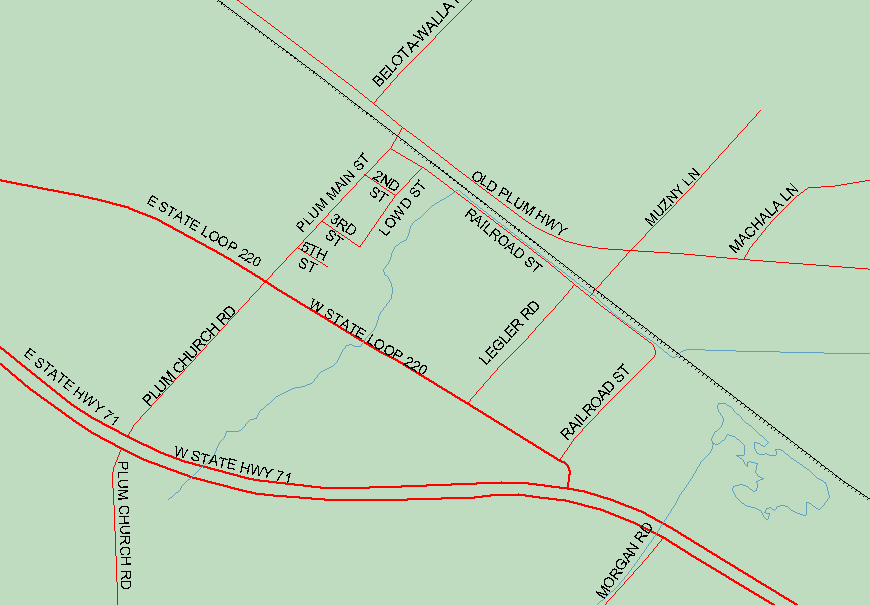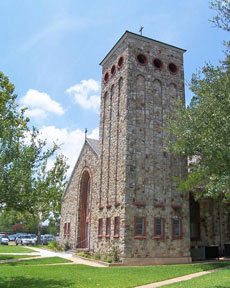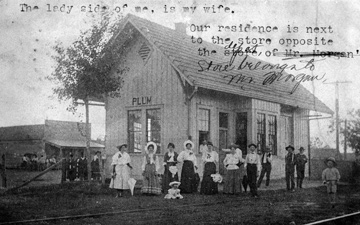Plum in 1893
Transcribed by Rox Ann Johnson
For most of the nineteenth century, each Fayette County community was fairly self-sufficient. You didn’t need to travel outside your neighborhood for school or everyday business and most people tended to stay near home. However, the coming of the railroads in the 1880s made travel between communities much easier. P. E. Edmondson, the owner and editor of The La Grange Journal, took a trip to Plum to let his readers know what was going on just down the road and, perhaps, to pick up a few new subscribers there. Edmondson’s commentary appeared in the November 2, 1893 issue of his newspaper:
The editor visited Plum last Thursday and spent a half day among its citizens. The place, as is well known by the great majority of The Journal’s readers, is located on the M. K. & T. railway, and is the first village west of LaGrange, distant six miles, only.
Plum is the center of a very rich agricultural portion of the county, which is settled up by thrifty well-to-do farmers, but does not on that account make any pretentions of being anything more than a quiet unassuming village. The place has two stores, a saloon, steam gin, blacksmith shop and boarding house; the latter being kept by M. W. P. Karnes, who, with his good wife, entertains their guests in the good old southern hospitable style.
Messrs Killough Brothers are proprietors of the principal store and carry a very respectable stock of general merchandise.
These gentlemen have been located there nearly five years, and have by liberal and courteous treatment of their patrons built up an excellent trade which is still growing with each succeeding year. Few young business men can boast of more friends than “Dave” and John can.
The other store is owned by Peyton Washington, who has a partner. Both are colored and are getting some of the trade. They have been in business some time and, we presume, are satisfied with the patronage they receive.
Messrs Morgan Brothers are proprietors of the steam gin, and are well patronized, ginning this year, so far, about one thousand bales. They also run a farm adjacent to the village and are very successful as farmers. The Journal was informed they were the proprietors of the saloon, but employed a man to run it.
Dr. Phil Chapman, a gentleman of due attainments, is Plum’s only physician. In conversing with him he informed us that that section was quite healthy and had been for some time.
Plum’s public school was to open Monday with Miss Mamie Trousdale, daughter of Mr. and Mrs. J. M. Trousdale, of West Side a teacher. Miss Mamie is an intelligent and well qualified teacher, which combined with her zeal and energy, insures [sic] the citizens of Plum a good school.
During our visit we met beside those mentioned some of our friends and patrons among whom were J. B. and J. T. Barnhill, Ed Lowd and others.
The History of Sts. Peter and Paul Catholic Church in Plum
A Footprints of Fayette article by Katie Kulhanek
The community of Plum began in 1869 with the creation of the Second Plum Grove Baptist Church. Seeing the prosperity the railroad would bring them, settlers living in the area decided to lay out a townsite. John H. Killough, L. T. Morgan, and J. H. Drisdale purchased 20.6 acres of land in 1889 and thus began the formal organization of Plum, Texas. Although it were Baptist Texans (whose families had originally been from Tennessee) who first settled Plum, the little community attributes much of its history to the Czech settlers who built a strong cultural and religious base in the small town.
In November of 1890, Plum experienced a population growth that traces its roots to the immigration of Czech families from the area of Hovězí, Moravia to Plum. During this time, Bohemia and Moravia were under Austrian rule and were thus considered part of the Austro-Hungarian Empire—Czechoslovakia did not exist. The empire imposed strict rules and regulations on many aspects of daily life, including religion. In November of 1890, three Moravian families (families of John Matocha, Paul Kořenek, and Josef Vacula) decided to leave their homes in Hovězí and make the journey over to Texas in hopes of finding a better life. They most likely visited with other Czech families in Fayetteville and heard about the good farming land in Plum. On November 28th, 1890, John and Anna Matocha celebrated the birth of their daughter, Antonia – the first Czech child born in Plum. It didn’t take long for other Czech families to come over. The families John Kubala, Anton Zigal, Martin Kořenek, and Josef Horečka soon came to Plum in 1891 from the Fayetteville area. Due to the increase of Czech immigration, Catholicism quickly became the predominant religion in Plum.
For the first few years, Catholic Mass was held in the private homes of these Czech families. In 1893, Reverend Karel Beneš, the Czech pastor of the Hostýn parish was the first priest to say Holy Mass in Plum. After the first Czech wedding in Plum in 1895, that of Paul and Anna (Janus) Kořenek, Paul converted one of his rooms in their home into a chapel for Mass to be held there. In 1896, John Matocha held Mass in his home. After many years of discussion and desire for a church of their own, a committee was formed consisting of John Matocha, Paul Kořenek, Josef Pšenčík, Vincent Vašina, and Josef Kořenek to “study the feasibility of building a new church”. Mr. J. C. Brown donated one acre of land and the committee purchased another acre for $33.00 from Mr. F. Laut. The wooden frame church measuring 42 feet by 26 feet was finished just in time for the Christmas season. There was also a living place for the priest in one of the sacristies. The first Mass was offered by Father Beneš on the first Sunday of Advent in 1896. The cost of the new church had been at $359.23. In order to help pay for the cost of the church, “a collection was taken and $508 was collected by the church committee... The cost of the church was paid and the remaining money was spent in a fitting way - $116 was given to Father Beneš as a gift for his support and ministry and the remaining $32 was placed into the first official church treasury.”
A dedication was planned for the new church to be held on June 29th, 1897 – the feast day of Saints Peter and Paul. The parishioners sent out an advertisement in the La Grange Czech newspaper, the Svoboda, a week before the celebration;
“Blessing of the New Church in Plum, TX. After the services, there will be
dancing on a platform belonging to Paul Kořenek with music provided by the
Plum Orchestra. Eats and drinks for those in attendance will be free. Who does
not believe this – let him come and see for himself. June 29th.”
The dedication was a great success. At that first feast on June 29th, 1897, Father Beneš formally dedicated the new church and the Saints Peter and Paul Plum Parish was officially organized. One of the local women of Plum wrote a short letter describing the events and sent it to the Svoboda to be published:
“If no one has already reported to you about the celebration in Plum, then please publish this account. Early in the morning, carriages from all around began to gather. A large portion of them gathered at the home of Mr. Matocha, where the Širočký band played a march to start the celebration. There were little girls dressed as flower girls. The procession started to form with the Bluff organization and our local St. Vaclav society wearing their badges. Everything appeared very nice. Father Beneš came out of the church with the servers to greet the procession and then performed the blessing of the church. After the blessing, there was a solemn Mass and sermon, which was also attended by Father Lennartz of La Grange. At the end of the service, everyone departed to a grove of trees where the dinner was prepared. One-third of those in attendance were visitors. Before lunch was served, the band played several musical pieces for entertainment. After the lunch, the attendants began to depart for their homes.”
Due to the small size of the parish, it was decided that Plum would be a mission church of Hostýn. From 1893 to 1911, the first ten pastors who administered to Plum lived in Hostýn and traveled to Plum to perform Mass. For a short time from 1911 to 1919 Plum was a mission church of Smithville, and from 1921 to 1923 it was a mission church of Cistern. During the twenty-six years from 1893 to 1923, Plum was served by a total of eleven priests. Then in 1923, Father Paul Kašpar became the first resident pastor of Plum. Father Kašpar came to Plum with his family when he was a young boy and had attended church at Sts. Peter and Paul for most of his life. It was a wonderful opportunity for Father Kašpar to be able to serve the church he grew up attending. It was Father Kašpar’s decision that a rectory (the one that sits beside the church today) be built.
Father Kašpar was a dynamic priest who was proud of his Czech heritage. He was very concerned about the religious education of the parish’s young children and wanted them to be able to “get a sound Catholic education in their own native language”. Religious classes were previously held in the church, but this changed when Father Kašpar ordered construction of St. Jerome’s Parochial School in Plum. The school opened on October 1st, 1929 and by 1938 it had a record attendance of ninety-six students. St. Jerome’s was located in the parking lot between the current church and the church cemetery. The parochial school closed in 1954 after attendance had dropped to only twenty-six students.
One of the highlights of the parish history was when His Emminence Cardinal Archbishop of Prague, Bohemia, Primate of Czechoslovakia, Dr. Karel Kašpar came to visit Hostýn and Plum in 1926. In 1934, Father Paul Kašpar was transferred to Hostýn and Father Bronislav Heintze was sent to Plum. After a year, Father Kašpar came back and served at Plum until 1943. At that time, Hostýn actually became a mission church to Plum. Father Kašpar was once again transferred and this time Father Edward Janský took over. It was his decision to build a new church since the old one had been blown off its foundation twice during storms and was too small for the growing church population of 125 families. Father Janský and the parishioners decided that the new church would be “built as a monument to the young men and women from the parish serving their country in World War II”.
The new church was to be built next to the original one. Maurice J. Sullivan, a prominent Houston architect, drew up the plans. The new church was built out of native stone from nearby Muldoon and a beautiful fifty foot bell tower was placed on the right side of the church. The construction of the church is as follows:
“The members of the church with pick and shovel dug the granite like stone from the Minor Rock Quarry in Muldoon, which was donated by Mr. and Mrs. Minor – owners, and hauled to the church site. In ten months, the new stone church with a seating capacity of 400 was completed. The cost was approximately $30,000.”
The new church was completed after ten months of construction and on April 28th, 1946, it was dedicated. The Fayette County Record states that there were several thousand people in attendance and Bača’s Band provided music. The church was filled to capacity and people peered in from the windows to listen to the service. A meal was served afterwards in the K.J.T. Hall (which is now the dance hall). Instead of being dismantled, the old Sts. Peter and Paul Church was converted into a dining hall for the parishioners and it still stands today as the Church’s Parish Hall, right behind the new church.
The 1950s and 60s saw many different priests come to serve Plum as it was once again a mission church to Hostýn. But finally, on May 12th, 1966, Sts. Peter and Paul Parish became an independent parish. A list of some long-serving priests are as follows; Father Rudolph Hoffmann, Father William Halata (during his term Plum was a mission parish to Hostýn), Father Dan O’Brien, and Father Jerome Strýk. After Father Strýk’s death, Plum has had many different priests come in to serve the parish and continue to do so to this day with the current priest, Father Dan Kahlich, who administers to both Hostýn and Plum.
There have been many different religious organizations at Sts. Peter and Paul Parish, including St. Vaclav’s K.J.T. Society (organized on April 1st, 1894), St. Anne’s K.J.Z.T. Society (organized July 26, 1907), St. Martin’s K.J.T. Society (organized in 1913), The Farmer St. Isidore’s Society #10 (organized November 6, 1904), The Knights of Columbus (members belong to the La Grange Chromčik Council), the Ladies Altar Society, the Catholic Youth Organization (1940s-1970s), and the Parish Council.
Plum is proud to have had two of its sons become priests: Father Paul Kašpar and Father John J. Hanaček.
The annual parish feast that is continued to this day was first officially organized in 1927, although the first feast was in 1897. An advertisement taken out in the La Grange Journal announced the celebration; “K.J.T. Park. Plum, Texas….Excellent Dinner, Lunch-Supper, Races and Games, Bača’s Brass Band Playing Grand Ball at Night, Invitation to All”. The celebration, which is an all day affair, is always held on the last Sunday in June and closest to the feast day of Sts. Peter and Paul. The Parish originally held two feasts, one in June and the other in the fall. But since 1986, it was decided to only hold the June feast.
There are two cemeteries for the church. The first, old cemetery is located on an acre of land on Old Catholic Cemetery Lane that had been donated by Paul Kořenek three miles away from where the current church sits. He donated it to the church not long after the dedication was held in 1897. Many of the names at the old cemetery are of the original founders of Sts. Peter and Paul Plum Parish. There is a historical marker located at this cemetery. The new cemetery is located next to the church and is much larger.
Today, the 1946 church still stands and Mass is held every Sunday and throughout the week as well. The old church is still used quite often as the Parish Hall and the old K.J.T. Dance Hall continues to open its doors for the annual Plum Feast and other celebrations. Nearby the new cemetery sits silently watching the church grounds. The old cemetery sits farther out in the country, but always as a strong reminder of the courage and dedication of some of the first parishioners of Sts. Peter and Paul Catholic Church.


 See Related Articles
See Related Articles
